
PALACIO Y JARDINES
DEL
MARQUES DE FONTALBA
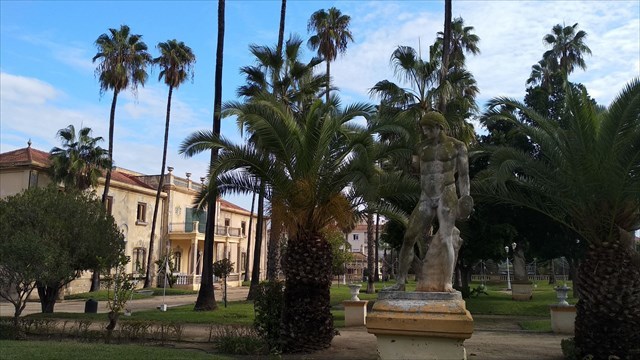
Con esta mini serie de tres cachés quiero dar a conocer y poner en valor uno de los lugares de mayor interés de la Vega baja de Alicante y que para mí ha resultado un agradable descubrimiento: el palacete y los jardines que en su día pertenecieron al Marqués de Fontalba y que hoy día son propiedad municipal del Ayuntamiento de Jacarilla.
ALGO DE HISTORIA DE JACARILLA….
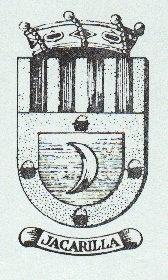 El remoto origen de lo que hoy es Jacarilla se puede rastrear hasta el siglo IV antes de Cristo, cuando en este lugar se localizaba un asentamiento ibérico. Por aquellas lejanas fechas, esta zona de la Vega Baja del Segura presentaba unas condiciones orográficas diferentes a las actuales; Jacarilla estaba en la orilla de una inmensa marisma alimentada por aluviones del Vinalopó y del Segura y que se extendía hasta el mar Mediterráneo.
El remoto origen de lo que hoy es Jacarilla se puede rastrear hasta el siglo IV antes de Cristo, cuando en este lugar se localizaba un asentamiento ibérico. Por aquellas lejanas fechas, esta zona de la Vega Baja del Segura presentaba unas condiciones orográficas diferentes a las actuales; Jacarilla estaba en la orilla de una inmensa marisma alimentada por aluviones del Vinalopó y del Segura y que se extendía hasta el mar Mediterráneo.
Se tiene noticia, por unas inscripciones encontradas en 1921 en la Serreta de Alcoy, de que por aquellos tiempos se produjo una nutrida peregrinación desde diferentes lugares hasta un centro espiritual para hacer ofrendas a la diosa de la fertilidad. En la plancha de plomo hallada figura una relación que detalla la procedencia de cada grupo de aquellas gentes, y el último en aparecer es Sakariskera, que venía a significar "el lugar donde se detiene el río de arena". El topónimo evolucionará a Xacariella, Hacarilla y, finalmente, a Jacarilla.
Tras la Reconquista, la familia Togores, según recoge el Llibre del Repartiments del Rey Jaime I de Aragón, va a ejercer su dominio indiviso durante siglos. En el XVII se independiza de Orihuela, y en el XIX obtiene su separación de Bigastro.

El término municipal de Jacarilla ocupa una superficie de 12,36 kilómetros cuadrados en la comarca de la Vega Baja del Segura, al sur de la provincia de Alicante (España). Situado a la margen derecha del Río Segura, con más de 2.800 horas de sol anuales y a 15 minutos de la costa del Mediterráneo. Cuenta con poco más de dos mil habitantes repartidos entre el casco urbano y núcleo de Vistabella.
EL PALACIO Y LOS JARDINES….
El Palacio y jardín del Marqués de Fontalba construido entre los años 1915 y 1922, está situado en las afueras del municipio.

En 1899, al morir el último señor de Jacarilla se dividió todo el territorio en partes iguales entre sus cuatro hijos. En 1915, uno de los herederos vendió sus propiedades (cerca de 850 hectáreas de terreno entre las que estaba enclavado el pueblo) al Marqués de Fontalba, quien había quedado prendado por la belleza del paraje natural conocido como "Vereda de las Palmeras", por un montante de alrededor del millón de pesetas.
El conjunto palaciego de Jacarilla fue ideado como lugar de retiro, esparcimiento y recreo en determinadas épocas del año. Se trata de un complejo construido entre 1916 y 1922 formado fundamentalmente por un palacio, amplios jardines a modo de gran parque, un pequeño bosque de pinos, iglesia y un cuartel para la Guardia Civil.
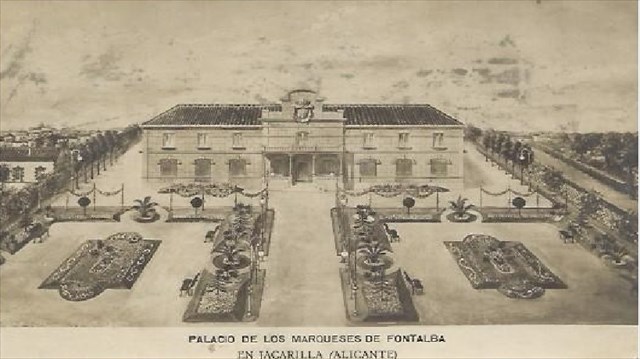
El palacio estaba concluido a comienzos de 1918. Se trata de una construcción de 800 metros cuadrados y planta en forma de “U”, de marcada horizontalidad y estricta simetría en su fachada, cuyo eje es un pórtico formado por pilares que sostienen una gran terraza.

En la década de 1920 sufrió una reforma que le dio su aspecto actual, en el que destaca la decoración de azulejos que combina motivos historicistas con otros de carácter tan castizo como las “manolas”.

Los jardines son parte fundamental del conjunto. Son casi 20.000 metros cuadrados de jardines y bosque, aderezados con una gran variedad de de frutales y especies (palmeras, naranjos, limoneros, araucarias excelsas, azahar de la China, alheña s, etc).
El jardín es de planta rectangular y estilo neohistoricista con elementos neoclásicos, árabes y renacentistas. Al entrar por la “Puerta de los Leones” se puede contemplar una avenida de esbeltas palmeras (réplica de otro lugar característico del municipio como es “La Vereda de las Palmeras).
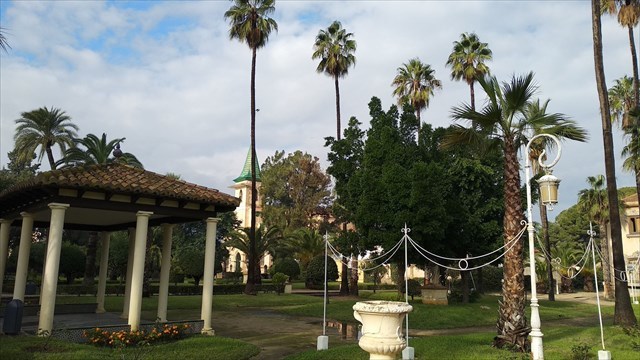

Aparte del interés botánico de las especies arbóreas, los jardines se enriquecen con fuentes, estatuas, un espectacular reloj de sol de azulejos, una gruta artificial dedicada a la Virgen de la Almudena, así como diversos elementos arquitectónicos de marcado gusto ecléctico (clasicistas y neoislámicos) destacando un estanque con una construcción cubierta a modo de pequeño pabellón o pagoda.
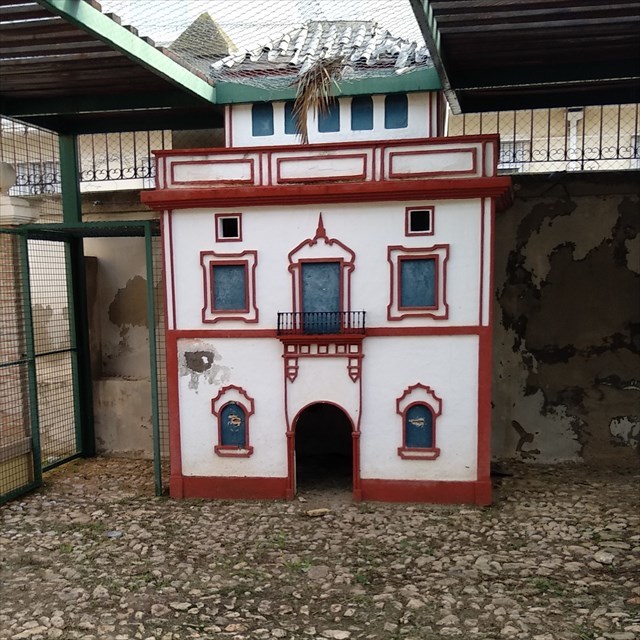
Muy curioso es un paseo repleto de jaulas concebidas como micro arquitecturas de variado estilo, que estuvieron repletas de aves exóticas e incluso de monos de Brasil.
Por último destacaremos la iglesia , hoy es parroquia de Ntra. Sra. de Belén, patrona de la localidad. Se concluyó en 1922 y en principio estaba concebida como oratorio particular de los Marqueses, pero con capacidad suficiente para servir de nueva iglesia al pueblo. Se construyó en piedra caliza del lugar, en estilo neogótico, con tres naves y bellas vidrieras. En el altar mayor se reservó un espacio exclusivo para los señores, con entrada independiente desde el exterior.
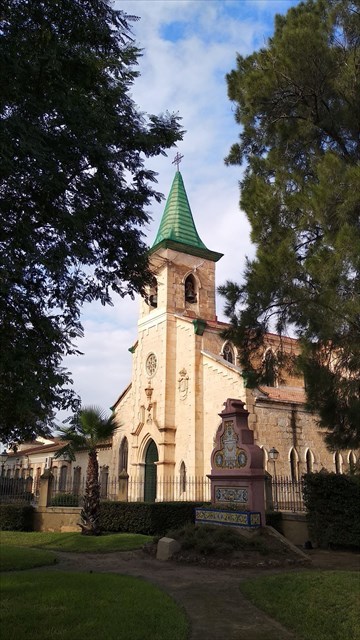
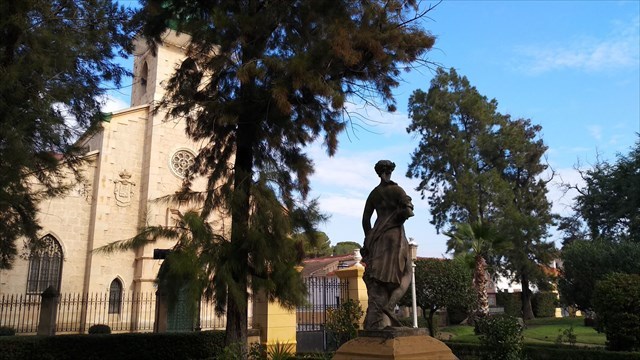
En la actualidad, salvo el cuartel de la Guardia Civil y la iglesia, el complejo ha pasado a ser de propiedad municipal (primero los jardines en 1993 y posteriormente el Palacio en 2009). Si bien los jardines se conservan en relativo buen estado y están abiertos al público, el palacio ha sufrido un enorme deterioro y está cerrado.
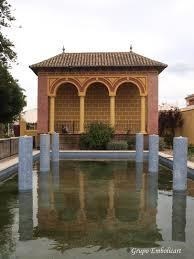
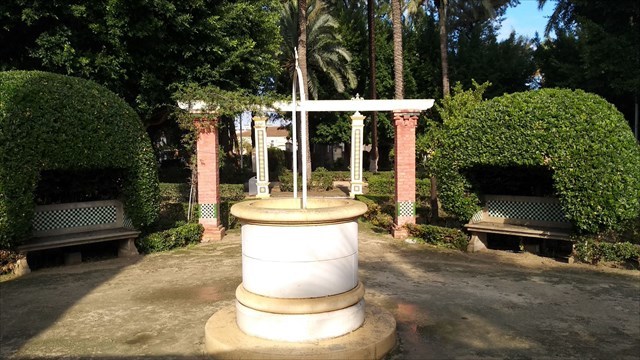
En definitiva se trata de un conjunto singular de gran valor cultural y paisajístico, que sorprendentemente no ha sido declarado Bien de Interés Cultural. La Dirección General de Patrimonio de la Generalitat Valenciana simplemente lo valora como Bien de Relevancia Local, a pesar de reconocer expresamente en su web que el jardín tiene “un alto interés histórico y botánico”.
EL CACHÉ
Se trata de un caché sencillo, fácil de localizar, situado en uno de los extremos del parque. Aunque la zona se encuentra habitualmente poco frecuentada, SE RUEGA SER MUY DISCRETOS A LA HORA DE BUSCAR Y RESTITUIR EL CACHÉ A SU POSICIÓN. Por favor, SE RUEGA DEJARLO TAL COMO SE ENCONTRÓ y tener cuidado al manipularlo.
IMPORTANTE: Elparque abre todos los días del año. No obstante, El horario de visita del mismo es variable a lo largo del año y se corresponde con las horas de luz solar, abriendo con la salida del sol y cerrando al anochecer. No obstante, en verano, permanece abierto hasta la medianoche



PALACE AND GARDENS
OF THE
MARQUES DE FONTALBA

With this mini series of three caches I want to make known and value one of the places of greatest interest of the Vega baja of Alicante and that for me has been a pleasant discovery: the palace and the gardens that once belonged to the Marquis of Fontalba and that nowadays are municipal property of the City council of Jacarilla.
SOME HISTORY OF JACARILLA ...
 The remote origin of what today is Jacarilla can be traced back to the 4th century BC, when an Iberian settlement was located in this place. For those distant dates, this zone of the Vega Baja del Segura presented orographic conditions different from the current ones; Jacarilla was on the shore of an immense marsh fed by alluvions of Vinalopó and Segura and that extended to the Mediterranean Sea.
The remote origin of what today is Jacarilla can be traced back to the 4th century BC, when an Iberian settlement was located in this place. For those distant dates, this zone of the Vega Baja del Segura presented orographic conditions different from the current ones; Jacarilla was on the shore of an immense marsh fed by alluvions of Vinalopó and Segura and that extended to the Mediterranean Sea.
It is known, for some inscriptions found in 1921 in the Serreta de Alcoy, that at that time there was a large pilgrimage from different places to a spiritual center to make offerings to the goddess of fertility. In the lead plate found there is a list that details the origin of each group of those people, and the last to appear is Sakariskera, which came to mean "the place where the river of sand stops". The toponym will evolve to Xacariella, Hacarilla and, finally, to Jacarilla.
After the Reconquest, the Togores family, according to the Llibre del Repartiments del Rey Jaime I of Aragón, will exercise its undivided domain for centuries. In the seventeenth he became independent from Orihuela, and in the nineteenth he obtained his separation from Bigastro.

The municipality of Jacarilla occupies a surface of 12.36 square kilometers in the region of Vega Baja del Segura, south of the province of Alicante (Spain). Located on the right bank of the Segura River, with more than 2,800 hours of sunshine per year and 15 minutes from the Mediterranean coast. It has a little more than two thousand inhabitants divided between the urban area and the center of Vistabella.
THE PALACE AND THE GARDENS….
The Palace and garden of the Marqués de Fontalba built between 1915 and 1922, is located on the outskirts of the municipality.

In 1899, when the last lord of Jacarilla died, the entire territory was divided in equal parts among his four children. In 1915, one of the heirs sold his properties (about 850 hectares of land between which the town was located) to the Marqués de Fontalba, who had been captivated by the beauty of the natural area known as "Vereda de las Palmeras", by an amount of around one million pesetas.
The palace complex of Jacarilla was designed as a place of retreat, recreation and recreation at certain times of the year. It is a complex built between 1916 and 1922 consisting mainly of a palace, large gardens as a large park, a small pine forest, church and a barracks for the Civil Guard.

The palace was completed at the beginning of 1918. It is a construction of 800 square meters and plant in the shape of "U", of marked horizontality and strict symmetry in its facade, whose axis is a portico formed by pillars that support a large terrace .

In the 1920s, it underwent a reform that gave it its current appearance, in which the decoration of tiles that combines historicist motifs with others of a character as traditional as the "manolas" stands out.

The gardens are a fundamental part of the whole. They are almost 20,000 square meters of gardens and forest, seasoned with a wide variety of fruit trees and species (palms, orange trees, lemon trees, lush araucarias, orange blossom of China, henna s, etc).
The garden is rectangular in style and neohistoricist with Neoclassical, Arab and Renaissance elements. Upon entering through the "Puerta de los Leones" you can see an avenue of slender palm trees (replica of another place characteristic of the municipality as "La Vereda de las Palmeras").


Aside from the botanical interest of the arboreal species, the gardens are enriched with fountains, statues, a spectacular sundial of tiles, an artificial grotto dedicated to the Virgin of the Almudena, as well as diverse architectural elements of marked eclectic taste (classicists and neoislámics ) highlighting a pond with a covered construction as a small pavilion or pagoda.

Very curious is a walk full of cages conceived as micro architecture of varied style, which were full of exotic birds and even Brazilian monkeys.
Finally, we will highlight the church, today it is the parish of Ntra. Sra. De Belén, patron saint of the town. It was completed in 1922 and was originally conceived as a private oratory of the Marquises, but with sufficient capacity to serve as a new church for the people. It was built in local limestone, in neo-Gothic style, with three naves and beautiful stained-glass windows. On the main altar reserved an exclusive space for the lords, with independent entrance from the outside.


At present, except for the Civil Guard barracks and the church, the complex has become municipal property (first the gardens in 1993 and then the Palace in 2009). Although the gardens are kept in relative good condition and are open to the public, the palace has suffered a huge deterioration and is closed.


In short, it is a unique ensemble of great cultural and landscape value, which has surprisingly not been declared an Asset of Cultural Interest. The General Directorate of Heritage of the Generalitat Valenciana simply values it as a Locally Relevant Property, although it expressly acknowledges on its website that the garden has "a high historical and botanical interest".
THE CACHÉ
It is a simple cache, easy to locate, located at one end of the park. Although the area is usually little frequented, PLEASE BE VERY DISCREET AT THE TIME OF SEARCHING AND RESETTING THE CACHÉ TO IT POSITION. Please, BE ASKED TO LEAVE IT AS IT WAS FOUND and be careful when handling it.
IMPORTANT: The park is open every day of the year. However, the visit time of the same is variable and corresponds to the hours of sunlight, opening with sunrise and closing at nightfall. However, in summer, it remains open until midnight.

